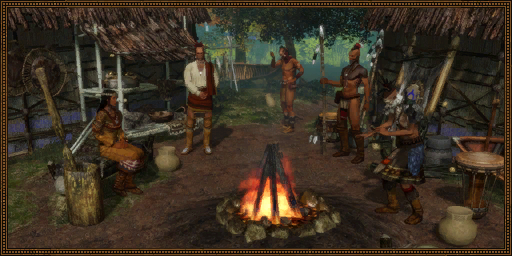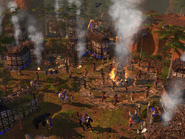| This article is about the major civilization in Age of Empires III: The WarChiefs. For the minor civilization in Age of Empires III, see Iroquois (minor native). |
The Haudenosaunee civilization's music theme in the Definitive Edition
The Haudenosaunee (pronounced "hoe-dee-no-SHOW-nee", known as the Iroquois before the Definitive Edition[1]) is a Native American civilization that thrived in the northeastern part of North America.
The Haudenosaunee first appear as a minor civilization in Age of Empires III, and introduced as a playable civilization in Age of Empires III: The WarChiefs.
Home City
Overview
The Haudenosaunee are more like the Europeans than the other Native American civilizations, being the only native civilization with access to an artillery unit.
Almost all of the Haudenosaunee's units are ranged units, with the exception of Kanya Horseman and one of the two melee siege weapons of the game, the Ram (the other being the Flail Elephant of the Indians).
Haudenosaunee start out with a Travois which can build most buildings for free. They also have a unique Founder Ceremony in the Community Plaza which spawns more Travois, as well as the Earth Mother Ceremony, which boosts population cap.
The Forest Prowler is a great skirmisher-type unit. It is extremely effective against Heavy Infantry, while being relatively cheap. With several upgrades, and supported by a robust economy, they function even better. Additionally, they perform better against light cavalry (such as Dragoons and Yabusame) than the average skirmisher.
The Aenna is another effective anti-infantry unit. Although not in the same league as the Forest Prowler, it costs 100 food total, allowing a Haudenosaunee player to focus completely on food for their economy, furnishing them with a massively effective and cost-effective anti-infantry army.
Haudenosaunee cavalry are their worst units, but Musket Riders, when adequately upgraded, can provide excellent anti-cavalry support. Players should focus on infantry and siege weapons and ensure their War Chief is in the center of unit groups to enable extra hit points for them.
Features
- Travois build most buildings for free
- War Chief aura increases the hit points of nearby friendly units
- Starts with a Travois and all Trading Post sites visible
- Cannot gather coin by mining; build a Tribal Marketplace next to a mine and assign Villagers on it to gather coin from the mine instead
- Build the Community Plaza and task Villagers on it to perform powerful ceremonies
- Choose Tribal Council members to advance in Age
Unique units
 Haudenosaunee War Chief: The leader of your Tribe. Possesses many powerful bonuses and abilities. Explores, fights, builds Town Centers and Trading Posts.
Haudenosaunee War Chief: The leader of your Tribe. Possesses many powerful bonuses and abilities. Explores, fights, builds Town Centers and Trading Posts. Villager: Villager that gathers resources.
Villager: Villager that gathers resources. Travois: Builds buildings.
Travois: Builds buildings. Warrior: Quick-training Native defender who quickly loses hitpoints, becoming less effective over time.
Warrior: Quick-training Native defender who quickly loses hitpoints, becoming less effective over time. Healer: Heals injured units.
Healer: Heals injured units. Aenna: Bowman. Good against infantry.
Aenna: Bowman. Good against infantry. Tomahawk: Haudenosaunee warrior that hurls tomahawks into battle. Good against cavalry.
Tomahawk: Haudenosaunee warrior that hurls tomahawks into battle. Good against cavalry. Forest Prowler: Stealthy ranged infantry. Good against infantry and in an ambush.
Forest Prowler: Stealthy ranged infantry. Good against infantry and in an ambush. Kanya Horseman: Light cavalry armed with hand weapons.
Kanya Horseman: Light cavalry armed with hand weapons. Musket Rider: Ranged cavalry. Good against cavalry.
Musket Rider: Ranged cavalry. Good against cavalry. Ram: Siege warrior. Good against buildings.
Ram: Siege warrior. Good against buildings. Mantlet: Tough Haudenosaunee support unit used to shield your army from enemy fire.
Mantlet: Tough Haudenosaunee support unit used to shield your army from enemy fire. Light Cannon: Light artillery. Good against infantry and artillery.
Light Cannon: Light artillery. Good against infantry and artillery. Canoe: Native boat that can attack or transport units.
Canoe: Native boat that can attack or transport units. War Canoe: Strong in naval combat when built in number.
War Canoe: Strong in naval combat when built in number.
Unique buildings
 Longhouse: Haudenosaunee Longhouse. Supports 15 population.
Longhouse: Haudenosaunee Longhouse. Supports 15 population. Farm: Slow, infinite source of Food. Limited to 10 gatherers.
Farm: Slow, infinite source of Food. Limited to 10 gatherers. Tribal Marketplace: Source of Coin, must be built next to a mine. Limited to 10 gatherers.
Tribal Marketplace: Source of Coin, must be built next to a mine. Limited to 10 gatherers. Community Plaza: Task Villagers on the Community Plaza to perform powerful ceremonies.
Community Plaza: Task Villagers on the Community Plaza to perform powerful ceremonies. War Hut: Trains and upgrades infantry units as well as defends an area with a ranged attack
War Hut: Trains and upgrades infantry units as well as defends an area with a ranged attack Corral: Trains and upgrades hand and ranged cavalry.
Corral: Trains and upgrades hand and ranged cavalry. Siege Workshop: Trains and upgrades artillery.
Siege Workshop: Trains and upgrades artillery.
Unique ceremonies
 Founder Ceremony: Spawns Travois
Founder Ceremony: Spawns Travois Earth Mother Ceremony: Increases population
Earth Mother Ceremony: Increases population
Home City Cards
- Main article: Haudenosaunee Home City Cards
In-game dialogue
The WarChiefs
Iroquois units speak Mohawk, one of the Iroquoian languages.
General
- Oh nahòten ("What is it?")
- Wakhthare ("I converse" or "I am speaking (about something)")
- Wake’ ("I am going" or "I am on my way")
- Ike’ ("I am going (by foot)")
- Hen (a variation of hen’en and enhenh: all words for "yes")
- Yekahtentyes ("I am leaving from here to go there", or "I am leaving there")
- Karihwenthos ("It gets worn out/destroyed"; when told to attack an enemy)
- Katorats ("I hunt" / "I am a hunter"; when told to attack an enemy)
Villager
- Female Build Kahnyotha - It stands upright/It sets it up
- Male Build Kahnyotha - It stands upright/It sets it up
- Female Farm Kyenthokwas - I harvest
- Male Farm Kyenthokwas - I harvest
- Female Gather Coin Ikkerons - Heap up/Accumulate
- Male Gather Coin Ikkerons - Heap up/Accumulate
- Female Gather Fruit Katstha - I use/am using/keep using, I am a user
- Male Gather Fruit Katstha - I use/am using/keep using, I am a user
- Female Gather Meat O’waronk - Meat
- Male Gather Meat O’waronk - Meat
- Female Gather Wood Oyente - Wood
- Male Gather Wood Oyente - Wood
- Many thanks to David Kanatawakhon, author of One Thousand Useful Mohawk Words (1992) and Let's Speak Mohawk (Kanyen'keha Tewatati) (2005), for his e-mail correspondence to verify these terms.
Definitive Edition
| This article is a stub. You can help the Wiki by expanding it. |
Haudenosaunee dialogue was heavily revised for the game's Definitive Edition, with only one voice actor providing all the male dialogue.
Villager
- Female Build
- Male Build
- Female Farm
- Male Farm
- Female Gather Coin
- Male Gather Coin
- Female Gather Fruit
- Male Gather Fruit
- Female Gather Meat
- Male Gather Meat
- Female Gather Wood
- Male Gather Wood
Trivia
- According to pre-release screenshots of The WarChiefs, the Haudenosaunee flag in the game would be the same flag used by the Iroquois Confederacy, featuring the Wampum belt.
History
The WarChiefs
| “ | The late sixteenth century confederation of five (later six) tribes into the Iroquois League in upstate New York created the most dominant native force in the northeast United States and eastern Canada. At the height of their empire in the late seventeenth century, they held sway over lands stretching from the Chesapeake Bay to the Mississippi and Illinois Rivers, and from Kentucky to Ontario. They are remarkable for many achievements, including their political system of checks and balances. The central law of its confederacy was to never war with each other. Against enemies, however, they usually presented a united political and military front . The Iroquois population had boomed following the adoption of agriculture in the fourteenth century, and they settled in villages of distinctive wood-framed and bark-covered longhouses. The first Europeans they encountered were the French, fighting against them in support of other tribes along the St. Lawrence. The Iroquois in turn traded for weapons with the Dutch of New Amsterdam. A series of wars followed, mostly over the fur trade. The Iroquois were often in the middle when France and Britain engaged in their periodic wars. By the later eighteenth century the Iroquois were being pressured by English settlers moving west from the coast and down the Ohio River Valley. When the American Revolution broke out in 1776, the Iroquois tried to remain neutral, but the league finally splintered and tribes fought on both sides. In 1779 George Washington sent three columns into Iroquois territory, burning forty villages, and driving most of them into Canada. The millions of acres the Iroquois once held in New York were reduced to a few small reservations, which they still hold today. | ” |
Gallery
References
Template:Civilizations (AoE3)




